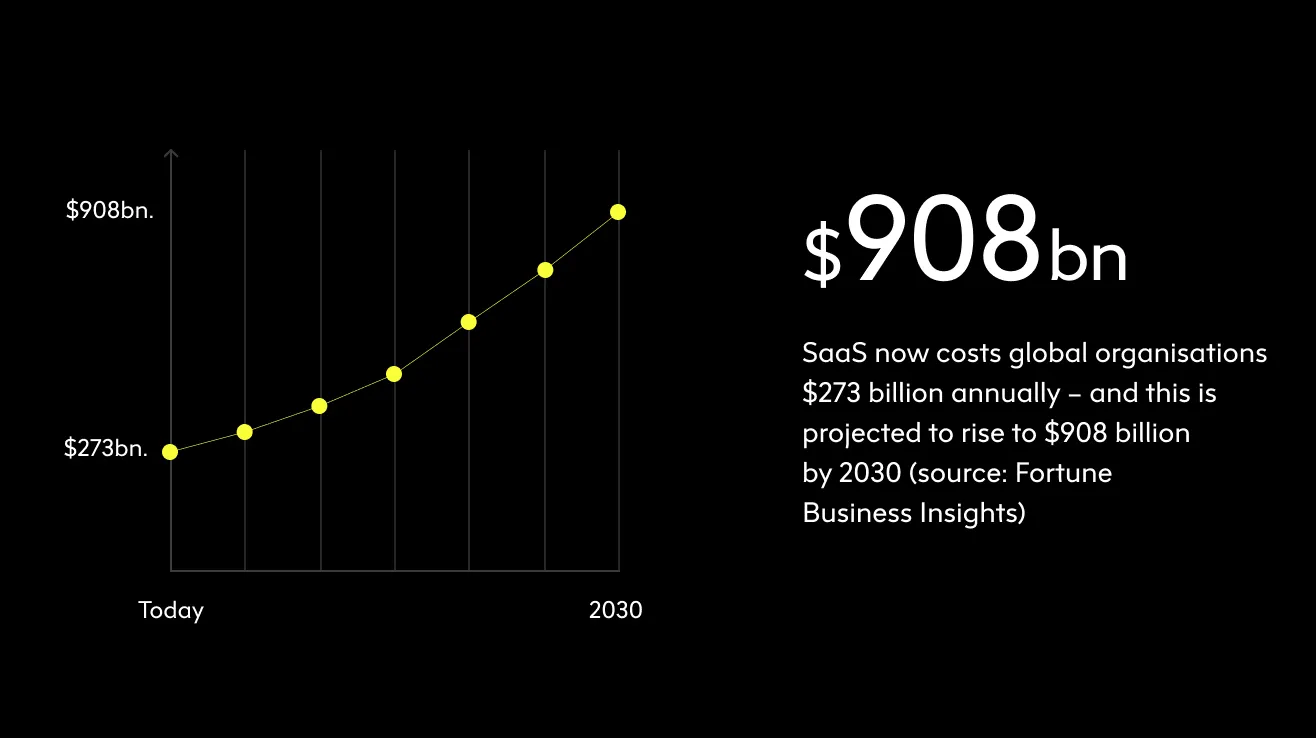Can Generative AI (GenAI) help you overcome the challenge of rising SaaS costs? Now you can replace expensive SaaS with your own bespoke GenAI systems – potentially saving your organisation millions – as discussed in our new GenAI whitepaper.
SaaS has brought big benefits – and bigger costs
Software as a Service (SaaS) has become a dominant model for delivering enterprise applications over the last two decades. SaaS offers many benefits, such as scalability, flexibility, and ease of use. However, SaaS also comes with some drawbacks, such as high recurring costs, vendor lock-in, and lack of customisation.
Here are some of the key statistics on SaaS usage and cost:
95% of organisations now use at least one SaaS solution (source: DemandSage)
SaaS applications now make up 70% of total company software use (source: ContentBeta)
SaaS now costs global organisations $273 billion annually – and this is projected to rise to $908 billion by 2030 (source: Fortune Business Insights)
Typical annual SaaS spend per enterprise employee ranges up to $9,600 (source: Cloudzero)
More than half (53%) of purchased SaaS licences go unused (source: Cloudzero)
Seeking new GenAI alternatives to expensive SaaS
As enterprise organisations face increasing pressure to innovate, optimise, and differentiate themselves in the market, they are looking for new ways to leverage the power of artificial intelligence (AI) to solve their business challenges. One of the most promising and disruptive trends in AI is the emergence of generative AI and large language models (LLMs).
LLMs are a type of neural network model that can process and generate natural language at a massive scale. These technologies have opened up new possibilities for enterprise applications, such as content creation, chatbots, coding assistance, problem-solving, and more.
Previously, your organisation may have looked to expensive SaaS providers for these kinds of capabilities. Now you have a massive new opportunity to cut these recurring SaaS costs – by building your own GenAI solutions, such as “co-pilot” assistants and AI agents. These are GenAI-powered tools that collaborate with human users to achieve a goal or complete a task, such as drafting emails, writing code, or assisting with decision-making.
Projection of SaaS costs by 2030
Capitalise on your existing IP with GenAI
A major advantage of new GenAI technologies over SaaS is that your company can better capitalise on your existing in-house knowledge, experience, data and intellectual property (IP).
This brings more efficiency for your organisation, since you can now develop and own GenAI-enabled digital products and services easily and flexibly, using a growing range of LLMs available in the market.
GenAI tools can potentially save your organisation millions on administrative costs and SaaS subscriptions, monetise your IP in new ways, and drive other benefits for your bottom line.
By creating and controlling these solutions in-house, you can make them more adaptable to the specific needs of your company. Your GenAI tools will be owned by your organisation and designed for your specific business needs, This is in contrast to SaaS offerings, which are middle-ground solutions, made to be used by many different companies – who actually in many cases pay expensive recurring fees to use only a portion of the SaaS solution’s features.
The benefits of building your own GenAI solution
Much of the power of a GenAI solution comes from the underlying LLM. If you purchase a GenAi solution via a SaaS vendor, the majority of the cost will usually be for using a general-purpose LLM – which your organisation can now purchase directly at lower cost. Any added value that a SaaS vendor provides on the top of this LLM can now be done better and cheaper by your organisation internally. This increasingly makes any SaaS GenAI offering look like an expensive second-best option.
By building your own GenAI solutions, your organisation can gain many other advantages, such as:
Cost saving: By owning their own GenAI solutions based on LLMs, enterprise organisations can reduce their dependence on SaaS providers – and replace the operating expenditure high recurring subscription fees with a one-off capital expenditure. They can also optimise their GenAI solutions for their specific use cases and data, reducing the computational and storage costs associated with training and running them.
Increasing productivity: Generative AI solutions can help enterprises automate and augment many tedious and time-consuming tasks, such as writing emails, summarising documents, generating code, and more. This can free up employees to focus on more creative and value-added activities, boosting their efficiency and satisfaction.
GenAI can free up employees to focus on more creative and value-added activities
Competitive edge: By developing their own AI systems and LLMs, enterprise organisations can create unique and innovative solutions that differentiate them from their competitors. They can also leverage their proprietary data and domain knowledge to fine-tune their GenAI systems and LLMs for better performance and accuracy.
Control and security: By managing their own GenAI systems and LLMs, enterprise organisations can have more control and visibility over how their data and GenAI models are used and accessed. They can also ensure that their GenAI systems and LLMs comply with their ethical and regulatory standards and protect their intellectual property and customer privacy.
Real-world GenAI enterprise success stories
Big-name examples of enterprise organisations that are building their own Generative AI systems and LLMs include:
Walmart: The retail giant has developed its own GenAI systems to power its internal conversational interfaces, such as Ask Sam and My Assistant. These tools help employees locate items, access store maps, look up prices, view sales information, check messages, and learn about the company’s policies and benefits.
Staff utilizing GenAI tools to assist them in locating items within the store
Elsevier: This leading provider of scientific, technical, and medical information has built its own generative AI tool, called Scopus, that helps researchers find and analyse academic literature. Scopus uses LLMs to understand natural language queries, generate summaries, and provide insights and recommendations.
As these examples show, enterprise organisations are harnessing the power of generative AI and LLMs to create their own AI-driven solutions and products. However, building and deploying generative AI systems and LLMs is not an easy task. It requires a combination of technical expertise, business acumen, and strategic vision.
Find your partner for the GenAI-enabled organisation
This is where a digital product consultancy like Elsewhen can help. We work with enterprise organisations to design, develop, and deliver their bespoke GenAI-driven solutions and products. Elsewhen has extensive experience and knowledge in generative AI and LLMs, as well as integrating GenAI with other enterprise technologies.
We can help you with every aspect of your GenAI and LLM journey, from identifying opportunities and designing experiments, to iterating and expanding your GenAI strategy, to navigating and managing the risks and challenges of GenAI implementation and adoption.
If you’re ready to learn more about how you can achieve your business GenAI goals and reduce your SaaS costs, please get in touch with us.
You can also read our new GenAI whitepaper, in which we outline the emergence of generative AI and LLMs, highlight GenAI capabilities and product paradigms, and explore potential business impacts and best practices.
Download the whitepaper: Digital Transformation in the Era of Generative AI
